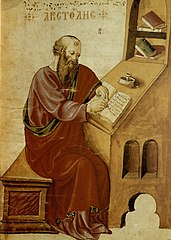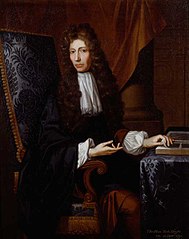Aristotle (385 B.C.E. - 323 B.C.E.)
 Aristotle was born in 385 B.C.E. in Macedonia, Greece, and while his contributions to the fields of medicine and science occurred centuries before many of his books were published and circulated widely, his observations and theories informed scientific and medical knowledge well into the 18th century. Particularly important were his classification of animals, plants, and humans, called the Scala Naturae (Natural Scale); for this he is considered one of the father's of human and animal biology. He had a teleological view of nature, that is he believed that plant and animal life could be understood by examining the functions they served. Through this lens he closely observed the biology of both humans and animals, and proposed origins and functions of human generation (i.e reproductive qualities of semen), as well as the differences between the arteries and the veins, and the purpose of the lungs to breathe air. His views on human reproduction were popularized at the turn of the 17th century in a book known as Aristotle's Masterpiece, though the book was not written by him. Surviving important works of Aristotle include The History of Animals (In hoc volumine ha︠e︡c continentur Aristotelis De historia animalium libri ix.), which dealt with natural sciences, and The Problems of Aristotle (Problemata Aristotelis ac philosophorum medicorumque complurium) which focused on human physiology.
Aristotle was born in 385 B.C.E. in Macedonia, Greece, and while his contributions to the fields of medicine and science occurred centuries before many of his books were published and circulated widely, his observations and theories informed scientific and medical knowledge well into the 18th century. Particularly important were his classification of animals, plants, and humans, called the Scala Naturae (Natural Scale); for this he is considered one of the father's of human and animal biology. He had a teleological view of nature, that is he believed that plant and animal life could be understood by examining the functions they served. Through this lens he closely observed the biology of both humans and animals, and proposed origins and functions of human generation (i.e reproductive qualities of semen), as well as the differences between the arteries and the veins, and the purpose of the lungs to breathe air. His views on human reproduction were popularized at the turn of the 17th century in a book known as Aristotle's Masterpiece, though the book was not written by him. Surviving important works of Aristotle include The History of Animals (In hoc volumine ha︠e︡c continentur Aristotelis De historia animalium libri ix.), which dealt with natural sciences, and The Problems of Aristotle (Problemata Aristotelis ac philosophorum medicorumque complurium) which focused on human physiology.
Source: Aristotle Anniversary Year: Remembering the Contributions to Medicine and human biology of this great polymath (Spanish) Rev Med Chile, 2016; 144: 1497-1501
Image Caption: Aristotle at his writing-desk. Miniature in the manuscript Vienna, Österreichische Nationalbibliothek, Cod. phil. gr. 64, fol. 8v. / Public Domain
Boerhaave (1668-1738)
Her man Boerhaave was born December 31, 1668 in Voorhout (then the Dutch Republic, what is now The Netherlands near Leiden). Boerhaave attended the University of Leiden in 1684 on a scholarship where he studied philosophy and theology. During his education he became interested in medicine and in 1693 he entered the University of Harderwijk, where he earned his medical degree. Boerhaave became a lecturer at Leiden in 1701, giving popular lectures on both the practice and theory of medicine. He published Institutiones Medicae in 1708 and in 1709, his Aphorisms on the Recognition of Diseases. From 1710 to 1720 he held the chairs of medicine, chemistry and botany. While he has few original discoveries to his name (excepting Boerhaave's syndrome-- the perforation of the esophagus), Boerhaave is said to have revitalized the practice of bedside teaching, emphasizing the use of medical history and a physical exam, followed by diagnosis, prognosis, and a treatment plan.
man Boerhaave was born December 31, 1668 in Voorhout (then the Dutch Republic, what is now The Netherlands near Leiden). Boerhaave attended the University of Leiden in 1684 on a scholarship where he studied philosophy and theology. During his education he became interested in medicine and in 1693 he entered the University of Harderwijk, where he earned his medical degree. Boerhaave became a lecturer at Leiden in 1701, giving popular lectures on both the practice and theory of medicine. He published Institutiones Medicae in 1708 and in 1709, his Aphorisms on the Recognition of Diseases. From 1710 to 1720 he held the chairs of medicine, chemistry and botany. While he has few original discoveries to his name (excepting Boerhaave's syndrome-- the perforation of the esophagus), Boerhaave is said to have revitalized the practice of bedside teaching, emphasizing the use of medical history and a physical exam, followed by diagnosis, prognosis, and a treatment plan.
Source: Kyle, R. A., & Steensma, D. P. (2018). Herman Boerhaave -- master clinician and humanist. Mayo Clinic Proceedings, 93, e119-e120.
Image caption: Portrait of Herman Booerhaave by Cornelis Troost, Amsterdam Museum SA 38468/ Public Domain
Boyle (1627-1691)
Robert Boyle was born in January 25th, 1627 in Ireland and died December 31, 1691 in London England. He contributed work in the fields of  chemistry, hydrostatics, physics, medicine, earth sciences, natural history, and alchemy. He taught at Oxford from c. 1656 until 1668. Here he met many fellow natural philosophers including Christopher Wren and John Wilkins. In 1662 Boyle published his work later to become known as Boyle's law, showing the relationship between volume and pressure when mass and temperature are held constant. Boyle published on multiple subjects including color, chemistry, precious stones, and physiology.
chemistry, hydrostatics, physics, medicine, earth sciences, natural history, and alchemy. He taught at Oxford from c. 1656 until 1668. Here he met many fellow natural philosophers including Christopher Wren and John Wilkins. In 1662 Boyle published his work later to become known as Boyle's law, showing the relationship between volume and pressure when mass and temperature are held constant. Boyle published on multiple subjects including color, chemistry, precious stones, and physiology.
Source: https://www.britannica.com/biography/Robert-Boyle
Image source: Portrait of Robert Boyle by Johann Keresboom, ca. 1689/ Public Domain
Celsus (25.B.C.E - 50 A.C.E.)
 Aulus Cornelius Celsus was born in ca. 25 B.C.E. and died in ca. 50 A.C.E. He was an encyclopedist in Rome, and published a large encyclopedia, of which, De Re Medica, is believed to be the only surviving section. De Re Medica includes advice on diet, pharmacy, surgery and related fields. It was one of the best sources of medical knowledge in the Roman world and continued to inform medical practice for many centuries.
Aulus Cornelius Celsus was born in ca. 25 B.C.E. and died in ca. 50 A.C.E. He was an encyclopedist in Rome, and published a large encyclopedia, of which, De Re Medica, is believed to be the only surviving section. De Re Medica includes advice on diet, pharmacy, surgery and related fields. It was one of the best sources of medical knowledge in the Roman world and continued to inform medical practice for many centuries.
Source: https://en.wikipedia.org/wiki/Aulus_Cornelius_Celsus
Image Source: Aurelius Cornelius Celsus. Lithograph by P. R. Vigneron. Wellcome Library no. 1688i, Photo number: V0001047/ Public Domain
Culpeper (1616-1654)
Nicholas Culpeper was born October 18, 1616 and died 1654. Culpeper's most famous work was The English Physician, published in 1652. The  English Physician was also the first medical book to be published in North America in, Boston in 1708. Culpeper was an herbalist, a medical astrologer, and also published on midwifery, childbirth, and pediatrics. His work was rejected by the Royal College of the Physicians and the Society of Apothecaries, partly for his political beliefs, and partly for his publication of medical works in English instead of Latin.
English Physician was also the first medical book to be published in North America in, Boston in 1708. Culpeper was an herbalist, a medical astrologer, and also published on midwifery, childbirth, and pediatrics. His work was rejected by the Royal College of the Physicians and the Society of Apothecaries, partly for his political beliefs, and partly for his publication of medical works in English instead of Latin.
Sources: https://www.smithsonianmag.com/smart-news/how-nicholas-culpeper-brought-medicine-people-180965291/, http://exhibits.hsl.virginia.edu/herbs/english-physician/
Image Source: Astrological birth chart for Nicholas Culpeper. Wellcome Library reference: EPB 48152/C, Photo number: L0040341/ Public Domain
Fernel (1497-1558)
 Jean Fernel was born in Montdidier, France in ca. 1497. He coined the term physiology and pathology and became one of France's most prominent physicians by 1550. His legacy included the importance of observation and description versus experimenation. In 1542 he published one his most famous works, On the Natural Parts of Medicine (De Naturali Parte Mediciniae). In 1554 he published Medicina, a systematic survey of what was then known about human disease. It is based on this book that he is known as the father of pathology.
Jean Fernel was born in Montdidier, France in ca. 1497. He coined the term physiology and pathology and became one of France's most prominent physicians by 1550. His legacy included the importance of observation and description versus experimenation. In 1542 he published one his most famous works, On the Natural Parts of Medicine (De Naturali Parte Mediciniae). In 1554 he published Medicina, a systematic survey of what was then known about human disease. It is based on this book that he is known as the father of pathology.
Source: W. Bruce Fye, M.D., M.A. (1997). Profiles in cardiology: Jean François Fernel Clinical Cardiology, 20, 1037-1038.
Image Source: Portrait of Jean François Fernel. Engraving by Nicolas de Larmessin. , Smithsonian Libraries / Public Domain